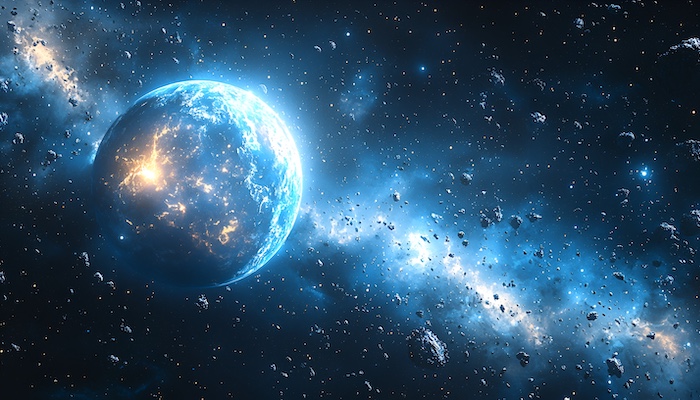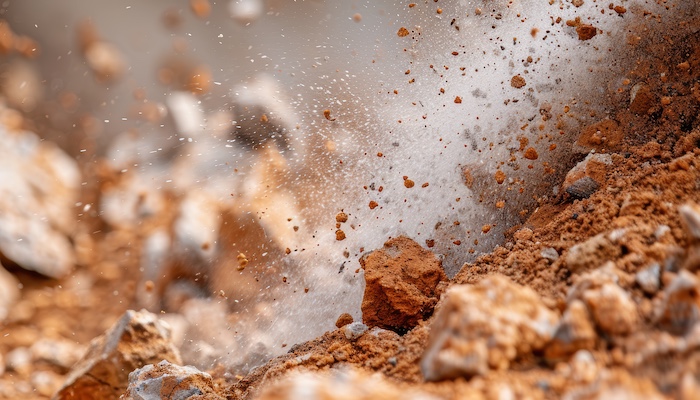A study published today in Nature reveals that Earth's first crust, formed about 4.5 billion years ago, probably had chemical features remarkably like today's continental crust.

Meteor bombardment: Early Earth was bombarded by meteors which played a crucial role in disrupting and recycling Earth's first crust.
This suggests the distinctive chemical signature of our continents was established at the very beginning of Earth's history.
Professor Emeritus Simon Turner from the Faculty of Science and Engineering at Macquarie University led the study, which included researchers from around Australia and the UK and France.
"This discovery has major implications for how we think about Earth's earliest history," says Professor Turner.
"Scientists have long thought that tectonic plates needed to dive beneath each other to create the chemical fingerprint we see in continents.
"Our research shows this fingerprint existed in Earth's very first crust, the protocrust - meaning those theories need to be reconsidered."
Rethinking early Earth formation
For decades, scientists have tried to identify when plate tectonics first began, marking the earliest evolution of life.
The chemical signature of rocks formed in subduction zones (where one plate has slipped beneath another) is distinctive in its low quantity of the element niobium.
This discovery completely changes our understanding of Earth's earliest geological processes.
Scientists thought finding the age of the earliest low-niobium rocks was the key to identifying when plate tectonics first began; but while a series of research teams tried to track this down, the results from each study were remarkably inconsistent.
"I began to wonder if we were asking the right question," says Professor Turner.
Together with collaborators across six universities, he created mathematical models simulating early Earth conditions when our planet's core was forming and an ocean of molten rock covered the planet's surface.
The team's calculations showed the protocrust – Earth's earliest crust formed during the Hadean eon (4.5 - 4 billion years ago) – would naturally develop the same chemical signatures found in today's continents, without needing plate tectonics to create them.
Chemical clues to formation
The initial results from the model showed that under the reducing conditions of early Earth, the element niobium would become siderophilic, or attracted to metal, sinking through the global magma ocean into the Earth's core.

Continental clues: Modern continental rocks carry chemical signatures from the very start of our planet's history, challenging current theories about plate tectonics.
"I realised there might be a connection between early core formation, high siderophile element patterns, and the infamous negative niobium anomaly observed in continental crust," says Professor Turner.
The distinctive signature of the continental crust matched the probable signature of material extracted from the mantle after core formation but before meteorites bombarded early Earth – solving the mystery of why the chemical signature appears in nearly all continental rocks regardless of age.
Early Earth's evolution
"Our research shows that the chemical signatures we see in continental crust were created in Earth's earliest period - regardless of how the planet's surface was behaving," says Professor Turner.
"This early crust was reshaped and made richer in silica thanks to a combination of meteor impacts, chunks of crust peeling off, and the beginning of plate movements."
The first crust likely broke into pieces that became thicker in some areas, forming the beginnings of continents.
As these pieces moved sideways, the molten magma between them created crust similar to what we find in ocean floors today.
Meteor impacts and plate tectonics
The heavy meteor bombardment during this early period caused extensive disruption and recycling of the crust.
Plate tectonics may have worked in fits and starts, triggered by meteor impacts until about 3.8 billion years ago, when meteor bombardment decreased dramatically as the early solar system's chaos gave way to more orderly orbits.
Plate tectonics then fell into a continuous, self-sustaining pattern.
"This discovery completely changes our understanding of Earth's earliest geological processes," says Professor Turner.
"It also gives us a new way to think about how continents might form on other rocky planets across the universe."






